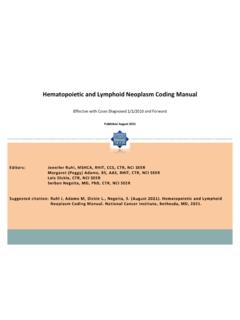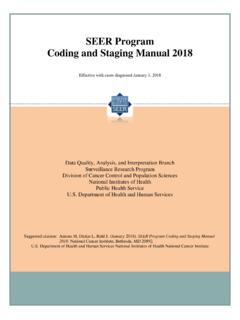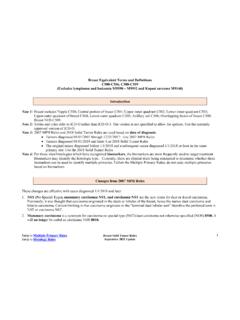Transcription of C180-C189, C199, C209 Introduction
1 Colon, Rectosigmoid, and Rectum Equivalent Terms and Definitions C180-C189, C199, C209 (Excludes lymphoma and leukemia M9590 M9992 and Kaposi sarcoma M9140) Jump to Multiple Primary Rules Jump to Histology Coding Rules Introduction Note 1: New terms and codes in these rules are based on the WHO Classification of Tumors of the Digestive System 2010 edition. Note 2: Ninety-eight percent of colon cancers are adenocarcinoma and adenocarcinoma subtypes. Note 3: Mixed histologies and specific variants or subtypes of adenocarcinoma other than mucinous/colloid or signet ring cell are rare. A less common combination is mixed adenoneuroendocrine carcinoma (MANEC) 8244 (previously called adenocarcinoma and carcinoid). The new terminology was originally proposed for tumors arising from goblet cell carcinoid but with more aggressive adenocarcinoma histology. It was also proposed because carcinoids are a subgroup of neuroendocrine carcinoma.
2 Pathologists may still diagnose adenocarcinoma and carcinoid, adenocarcinoid, or adenocarcinoma and a specific neuroendocrine tumor or adenocarcinoma arising from/with a NET (including specific types of NET-like goblet cell carcinoid). Over time, the histologic diagnoses will change to MANEC. Note 4: De novo (previously called frank) adenocarcinoma arises in the mucosa of the bowel, not in a polyp. Note 5: Terms Seen More Frequently: NET, NEC, GIST NET (neuroendocrine tumor): The term NET is gradually replacing carcinoid; however, some pathologists still use the term carcinoid NEC (neuroendocrine carcinoma): The term NEC includes small cell neuroendocrine carcinoma, large cell neuroendocrine carcinoma, and poorly differentiated neuroendocrine carcinoma GIST (gastrointestinal stromal tumor): o GISTs were originally thought to be smooth muscle tumors but are now thought to originate from the interstitial cells of Cajal, neuro-regulatory cells in the GI tract.
3 Prior to the implementation of an ICD-O-3 histology code for GISTs in 2001, they were reported as a GI sarcoma, usually leiomyosarcoma o GISTs are more common in the stomach (60%) and small intestine (30%), but 1-2% occur in the colon and 3% in the rectum o About a quarter of gastric GISTs are malignant o It is often difficult for the pathologist to determine the behavior of a GIST o GIST NOS becomes a reportable neoplasm beginning with cases diagnosed 1/1/2021 forward Note 6: Tables and rules refer to ICD-O rather than ICD-O-3. The version is not specified to allow for updates. Use the currently approved version of ICD-O. Note 7: 2007 MPH Rules and 2018 Solid Tumor Rules are used based on date of diagnosis. Tumors diagnosed 01/01/2007 through 12/31/2017: Use 2007 MPH Rules Colon Solid Tumor Rules September 2021 Update1 Colon, Rectosigmoid, and Rectum Equivalent Terms and Definitions C180-C189, C199, C209 (Excludes lymphoma and leukemia M9590 M9992 and Kaposi sarcoma M9140) Jump to Multiple Primary Rules Jump to Histology Coding Rules Tumors diagnosed 01/01/2018 and later: Use 2018 Solid Tumor Rules The original tumor diagnosed before 1/1/2018 and a subsequent tumor diagnosed 1/1/2018 or later in the same primary site: Use the 2018 Solid Tumor Rules.
4 Note 8: For those sites/histologies which have recognized biomarkers , the biomarkers are most frequently used to target treatment. Currently, there are clinical trials being conducted to determine whether these biomarkers can be used to identify multiple primaries and/or histologic type. Follow the Multiple Primary Rules; do not code multiple primaries based on biomarkers . Changes from 2007 MPH Rules These changes are effective with cases diagnosed 1/1/2018 and later. 1. 2007 Rules instruct Code the histology from the most representative specimen. For all sites except breast and CNS, 2018 Rules instruct Code the most specific histology from biopsy or resection. When there is a discrepancy between the biopsy and resection (two distinctly different histologies/different rows), code the histology from the most representative specimen (the greater amount of tumor). 2. Rectum and Rectosigmoid are now included with the Colon Rules.
5 In the 2007 MPH Rules, they were included with Other Sites. 3. There are new multiple primary rules which address anastomotic recurrence. 4. Neuroendocrine tumors (formerly carcinoid) arising in the appendix are reportable for cases diagnosed 1/1/2015 and forward. 5. Rule clarification: Pseudomyxoma peritonei (accumulation of mucin-secreting tumor cells in the abdominal or pelvic cavity) now has a two-tiered system (WHO 2010) that classifies pseudomyxoma peritonei as either high-grade or low-grade (see below). Pseudomyxoma peritonei is usually associated with mucinous tumors of the appendix and is rarely associated with ovarian mucinous tumors. High-grade pseudomyxoma peritonei is malignant /3 Low-grade pseudomyxoma peritonei is not malignant /1 See Histology Rules for coding instructions Colon Solid Tumor Rules September 2021 Update2 Colon, Rectosigmoid, and Rectum Equivalent Terms and Definitions C180-C189, C199, C209 (Excludes lymphoma and leukemia M9590 M9992 and Kaposi sarcoma M9140) Jump to Multiple Primary Rules Jump to Histology Coding Rules 6.
6 There are dysplasias which have been assigned an in situ behavior code /2 in WHO and in the ICD-O Update. Despite becoming a /2, they are not reportable in the US. They are reportable in Canada. Dysplasia was not collected in the past. If dysplasia is added to the database with the same code as in situ tumors, there will be a huge upsurge in the incidence of in situ neoplasms. The various agencies are looking for solutions to this issue. There would be no way to separate the dysplasias from the in-situ neoplasms in the database, which would cause problems with surveillance (long-term studies) since the prognosis and probabilities of disease progression are different between an in-situ tumor and a dysplasia Pathologists frequently use the term severe dysplasia or high grade dysplasia in place of carcinoma in situ. Code CIS only if the pathologist expressly states CIS 7. Polyps are now disregarded when coding histology. For example, adenocarcinoma in an adenomatous polyp is coded as adenocarcinoma 8140.
7 For the purposes of determining multiple primaries, tumors coded as adenocarcinoma in a polyp for pre-2018 cases should be treated as adenocarcinoma 8140. New codes/terms are identified by asterisks (*) in the histology table in the Terms and Definitions. New for 2022 1. Timing changes to rules M7 and M8: The timing for subsequent tumors at the anastomosis has changed from 24 months to 36 months. The change is effective for cases diagnosed beginning 1/1/2022 forward. For cases diagnosed 1/1/2018 through 12/31/2021, the timing rule remains at 24 months. 2. Low grade appendiceal neoplasm (LAMN) will become reportable effective for cases diagnosed 1/1/2022 forward. LAMN may be either in situ 8480/2 or malignant 8480/3 based on physician statement of behavior. LAMN diagnosed prior to 1/1/2022 are not reportable. Colon Solid Tumor Rules September 2021 Update3 Colon, Rectosigmoid, and Rectum Equivalent Terms and Definitions C180-C189, C199, C209 (Excludes lymphoma and leukemia M9590 M9992 and Kaposi sarcoma M9140) Jump to Multiple Primary Rules Jump to Histology Coding Rules Equivalent or Equal Terms These terms can be used interchangeably: And; with Note: And and with are used as synonyms when describing multiple histologies within a single tumor.
8 Carcinoid; NET; neuroendocrine tumor Carcinoma; adenocarcinoma; o A histology type must be stated for these terms to be equal o Example: Mucinous carcinoma and mucinous adenocarcinoma are both coded 8480 De novo; frank adenocarcinoma (obsolete) Familial polyposis; familial adenomatous polyposis (FAP) 8220 Intramucosal; lateral extension within the mucosal layer of the GI tract Invasion through colon wall; extension through colon wall; transmural Note: The term transmural is used to describe extension through all layers of the wall, but not past the wall OR extension through the serosa into the mesentery. Read the pathology report carefully. Mucinous; mucoid; mucous; colloid Neuroendocrine carcinoma; NEC Polyp; adenoma; polyp NOS; adenomatous polyp Note 1: The term polyp means projecting from a surface. Note 2: There are many kinds of polyps. Most common are adenomas, which are part of the adenoma-cancer sequence.
9 Note 3: Other types of polyps include hyperplastic, juvenile, Peutz-Jeghers and serrated adenoma/polyp. Serosa; visceral peritoneum Simultaneous; existing at the same time; concurrent; prior to first course treatment Site; topography Tumor; mass; tumor mass; lesion; neoplasm o The terms tumor, mass, tumor mass, lesion, and neoplasm are not used in a standard manner in clinical diagnoses, scans, or consults. Disregard the terms unless there is a physician s statement that the term is malignant/cancer o These terms are used ONLY to determine multiple primaries o Do not use these terms for casefinding or determining reportability Type; subtype; variant Colon Solid Tumor Rules September 2021 Update4 Colon, Rectosigmoid, and Rectum Equivalent Terms and Definitions C180-C189, C199, C209 (Excludes lymphoma and leukemia M9590 M9992 and Kaposi sarcoma M9140) Jump to Multiple Primary Rules Jump to Histology Coding Rules Terms that are NOT Equivalent or Equal These terms are not equivalent.
10 There are no casefinding implications. Carcinoma, NOS 8010 is not equivalent to adenocarcinoma, NOS 8140 Component is not equivalent to subtype/type/variant Note: Component is only coded when the pathologist specifies the component as a second carcinoma. Exophytic and polypoid are not equivalent to either an adenoma or an adenomatous polyp. The terms exophytic and polypoid refer to anything projecting from the bowel mucosa into the lumen. The lesion may be benign, malignant, or inflammatory. Phenotype is not equivalent to subtype/type/variant Polypoid adenocarcinoma is not equivalent to adenocarcinoma in a polyp Colon Solid Tumor Rules September 2021 Update5 Colon, Rectosigmoid, and Rectum Equivalent Terms and Definitions C180-C189, C199, C209 (Excludes lymphoma and leukemia M9590 M9992 and Kaposi sarcoma M9140) Jump to Multiple Primary Rules Jump to Histology Coding Rules Table 1: Specific Histologies, NOS, and Subtypes/Variants Use Table 1 as directed by the Histology Rules to assign the more common histology codes for malignancies found in the colon, rectosigmoid and rectum.














